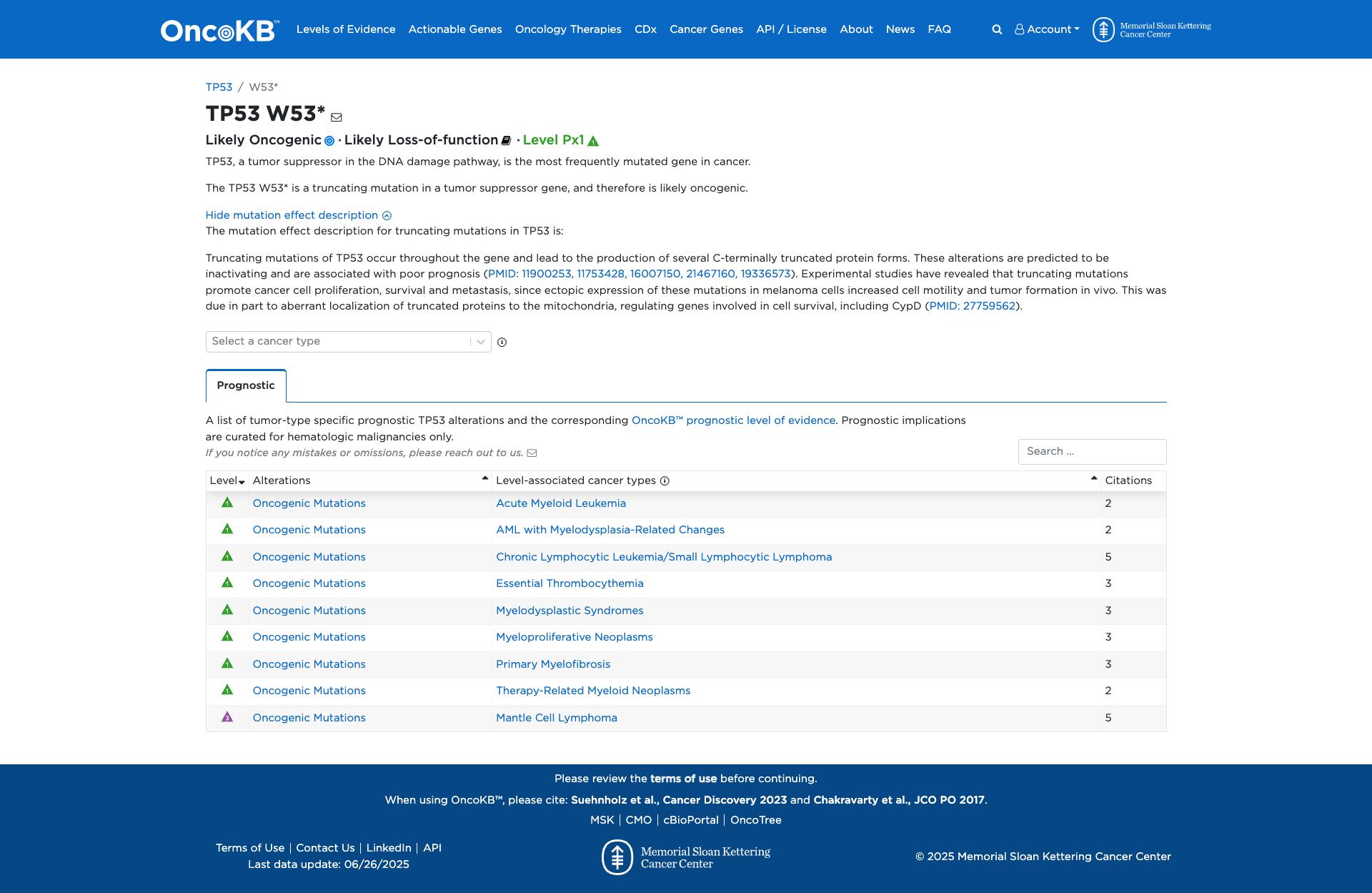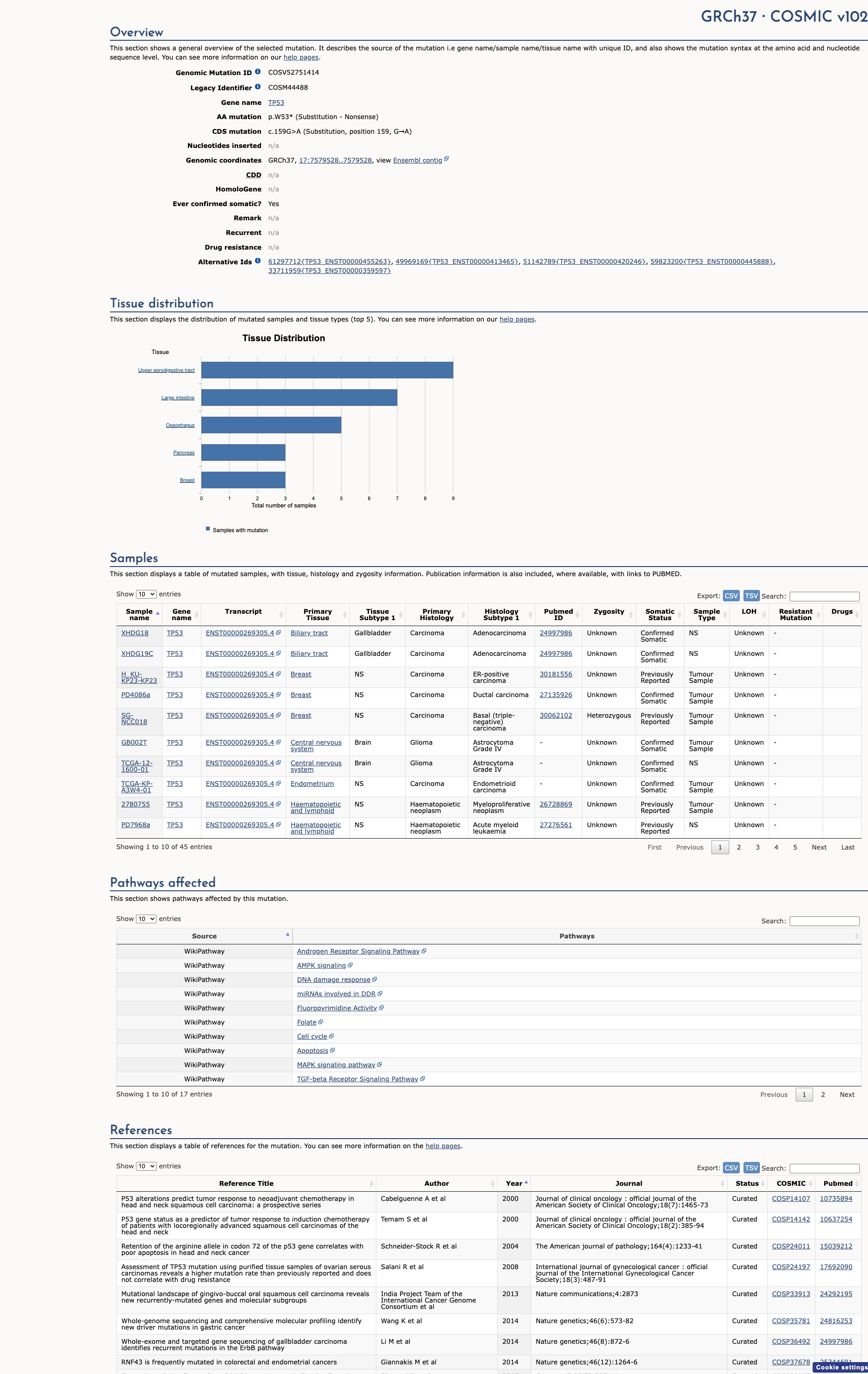TP53 c.159G>A, p.Trp53Ter
NM_000546.6:c.159G>A
COSMIC ID: COSM3712586, COSM44488
Pathogenic
Applying TP53-specific VCEP guidelines, p.W53* is a truncating variant predicted to undergo NMD (PVS1 Very Strong) and is absent from controls (PM2 Supporting) with a pathogenic assertion in ClinVar (PP5 Supporting). No additional criteria apply, yielding a Likely Pathogenic classification.
ACMG/AMP Criteria Applied
PVS1
PM2
PP5
Genetic Information
Gene & Transcript Details
Gene
TP53
Transcript
NM_000546.6
MANE Select
Total Exons
11
Strand
Reverse (−)
Reference Sequence
NC_000017.10
Alternative Transcripts
| ID | Status | Details |
|---|---|---|
| NM_000546.5 | RefSeq Select | 11 exons | Reverse |
| NM_000546.3 | Alternative | 11 exons | Reverse |
| NM_000546.4 | Alternative | 11 exons | Reverse |
| NM_000546.2 | Alternative | 11 exons | Reverse |
Variant Details
HGVS Notation
NM_000546.6:c.159G>A
Protein Change
W53*
Location
Exon 4
(Exon 4 of 11)
5'Exon Structure (11 total)3'
Functional Consequence
Loss of Function
Related Variants
Alternate Identifiers
COSM3712586, COSM44488
Variant interpretation based on transcript NM_000546.6
Genome Browser
Loading genome browser...
HGVS InputNM_000546:c.159G>A
Active Tracks
ConservationRefSeqClinVargnomAD
Navigation tips: Use mouse to drag and zoom. Click on features for details.
Clinical Data
Population Frequency
Global Frequency
0.0 in 100,000
Extremely Rare
Global: 0.0%
0%
0.05%
0.1%
1%
5%
10%+
ACMG Criteria Applied
PM2
This variant is not present in gnomAD (PM2 criteria applies).
Classification
1 publications
Pathogenic
Based on 8 submitter reviews in ClinVar
Submitter Breakdown
8 Path
Pathogenic
Likely Path.
VUS
Likely Benign
Benign
Publications (1)
This sequence change creates a premature translational stop signal (p.Trp53*) in the TP53 gene. It is expected to result in an absent or disrupted protein product. Loss-of-function variants in TP53 are known to be pathogenic (PMID: 20522432). This variant is not present in population databases (gnomAD no frequency). This premature translational stop signal has been observed in individual(s) with clinical features of Chompret-Bonaiti (PMID: 35246108). ClinVar contains an entry for this variant (Variation ID: 420659). For these reasons, this variant has been classified as Pathogenic.
Clinical Statement
This variant has been reported in ClinVar as Pathogenic (8 clinical laboratories).
COSMIC ID
COSM3712586, COSM44488
Recurrence
44 occurrences
PM1 Criteria
Applied
Criterion PM1 is applied based on the high recurrence in COSMIC database.
COSMIC Database Preview
Accessing full COSMIC database details requires institutional login or subscription. External links may prompt for authentication.
Functional Impact
Functional Domain
Hotspot Status
Hotspot
PM1
Mutation Count
22
Reported mutations in this domain
050100+
Domain Summary
This variant is located in a mutational hotspot or critical domain (22 mutations).
PM1 criterion applied.
Related Variants in This Domain
Functional Summary
The TP53 W53* variant is a truncating mutation that results in a premature stop codon, leading to the production of a truncated protein. Functional evidence indicates that truncating mutations in TP53 are inactivating, promoting cancer cell proliferation, survival, and metastasis. Experimental studies have shown that these mutations can increase cell motility and tumor formation, partly due to aberrant protein localization affecting cell survival pathways. Therefore, the TP53 W53* variant is functionally characterized as likely damaging, contributing to oncogenic processes.
Database Previews
OncoKB

JAX-CKB

Click on previews to view full database entries. External databases may require institutional access.
Computational Analysis
Pathogenicity Predictions
Predictor Consensus
Mixed/VUS
PP3 Applied
No
Additional Predictors
Benign:
CADD: 5.40
Neutral: Show all
VCEP Guidelines
Applied ACMG/AMP Criteria (VCEP Specific) VCEP Guidelines
PVS1
PVS1 (Very Strong)
According to VCEP guidelines, the rule for PVS1 is: 'Nonsense or frameshift variants predicted to undergo NMD when upstream of p.Lys351 are PVS1 Very Strong.' The evidence for this variant shows: c.159G>A results in p.W53*, a premature stop codon at amino acid 53 (upstream of p.Lys351), predicted to undergo NMD in TP53, where LOF is a known mechanism. Therefore, this criterion is applied at Very Strong strength because the variant is a truncating variant predicted to undergo NMD per VCEP PVS1 decision tree.
PS1
PS1 (Not Applied) Strength Modified
According to standard ACMG guidelines, the rule for PS1 is: 'Same amino acid change as a known pathogenic variant but different nucleotide change.' The evidence for this variant shows: p.W53* is a unique nonsense change, not matching any known pathogenic amino acid substitution. Therefore, this criterion is not applied because the variant does not result in the same amino acid change as a known pathogenic variant.
PS2
PS2 (Not Applied) Strength Modified
According to standard ACMG guidelines, the rule for PS2 is: 'De novo (both maternity and paternity confirmed) in a patient with the disease and no family history.' The evidence for this variant shows: no de novo data provided. Therefore, this criterion is not applied due to lack of de novo evidence.
PS3
PS3 (Not Applied) Strength Modified
According to VCEP guidelines, the caveat for PS3 is: 'PS3 should not be applied at any strength if PVS1 is applied at full strength.' The evidence for this variant shows: PVS1 was applied at Very Strong strength. Therefore, PS3 is not applied.
PS4
PS4 (Not Applied) Strength Modified
According to VCEP guidelines, the rule for PS4 is: 'Use proband counting points; ≥8 points yields Very Strong, etc.' The evidence for this variant shows: no case-counting data are available. Therefore, this criterion is not applied due to absence of case prevalence data.
PM1
PM1 (Not Applied) Strength Modified
According to VCEP guidelines, the rule for PM1 is: 'Missense variants within hotspot codons 175, 245, 248, 249, 273, 282 apply Moderate strength.' The evidence for this variant shows: p.W53* is a nonsense variant at codon 53, not a missense change within a defined hotspot. Therefore, PM1 is not applied.
PM2
PM2 (Supporting) Strength Modified
According to VCEP guidelines, the rule for PM2 is: 'Variant should have an allele frequency <0.00003 in gnomAD; apply at Supporting level.' The evidence for this variant shows: not present in gnomAD or other control databases. Therefore, PM2 is applied at Supporting strength because the allele is absent from large population datasets.
PM3
PM3 (Not Applied) Strength Modified
According to standard ACMG guidelines, the rule for PM3 is: 'Detected in trans with a pathogenic variant for a recessive disorder.' The evidence for this variant shows: TP53-related disease is autosomal dominant and no trans data apply. Therefore, PM3 is not applied.
PM4
PM4 (Not Applied) Strength Modified
According to standard ACMG guidelines, the rule for PM4 is: 'Protein length changes due to in-frame indels or stop-loss variants.' The evidence for this variant shows: p.W53* is a stop-gain (nonsense) variant, not an in-frame indel or stop-loss. Therefore, PM4 is not applied.
PM5
PM5 (Not Applied) Strength Modified
According to VCEP guidelines, the rule for PM5 is: 'Missense variant at a residue with ≥2 different pathogenic missense variants yields Strong strength.' The evidence for this variant shows: p.W53* is a nonsense change, not a missense variant at a residue with known pathogenic missense changes. Therefore, PM5 is not applied.
PM6
PM6 (Not Applied) Strength Modified
According to standard ACMG guidelines, the rule for PM6 is: 'Assumed de novo, but without confirmation of paternity and maternity.' The evidence for this variant shows: no de novo information. Therefore, PM6 is not applied.
PP1
PP1 (Not Applied) Strength Modified
According to VCEP guidelines, the rule for PP1 is: 'Cosegregation in ≥3 affected meioses across ≥1 families yields Supporting strength.' The evidence for this variant shows: no family segregation data. Therefore, PP1 is not applied.
PP2
PP2 (Not Applied) Strength Modified
According to standard ACMG guidelines, the rule for PP2 is: 'Missense variant in a gene with a low rate of benign missense variants.' The evidence for this variant shows: p.W53* is a nonsense variant. Therefore, PP2 is not applied.
PP3
PP3 (Not Applied) Strength Modified
According to VCEP guidelines, the rule for PP3 is: 'Missense variants with BayesDel ≥0.16 and/or SpliceAI ≥0.2 yield Supporting or Moderate strength.' The evidence for this variant shows: it is a nonsense variant and computational predictive scores are not relevant. Therefore, PP3 is not applied.
PP4
PP4 (Not Applied) Strength Modified
According to VCEP guidelines, the rule for PP4 is: 'Somatic observation with VAF 5–35% yields Supporting strength.' The evidence for this variant shows: no somatic VAF data provided. Therefore, PP4 is not applied.
PP5
PP5 (Supporting)
According to standard ACMG guidelines, the rule for PP5 is: 'Reputable source reports variant as pathogenic but evidence not available for independent evaluation.' The evidence for this variant shows: ClinVar lists p.W53* as pathogenic (8 clinical laboratories). Therefore, PP5 is applied at Supporting strength.
BA1
BA1 (Not Applied) Strength Modified
According to VCEP guidelines, the rule for BA1 is: 'Filtering allele frequency ≥0.001 in any continental subpopulation, excluding founder populations.' The evidence for this variant shows: allele frequency = 0. Therefore, BA1 is not applied.
BS1
BS1 (Not Applied) Strength Modified
According to VCEP guidelines, the rule for BS1 is: 'Filtering allele frequency ≥0.0003 but <0.001 in any continental subpopulation.' The evidence for this variant shows: allele frequency = 0. Therefore, BS1 is not applied.
BS2
BS2 (Not Applied) Strength Modified
According to VCEP guidelines, the rule for BS2 is: '≥8 unrelated healthy females ≥60 years without cancer yields Strong strength.' The evidence for this variant shows: no such observation. Therefore, BS2 is not applied.
BS3
BS3 (Not Applied) Strength Modified
According to VCEP guidelines, the rule for BS3 is: 'Functional assay data showing no loss of function yields Strong or Supporting strength.' The evidence for this variant shows: no functional data indicating preserved function. Therefore, BS3 is not applied.
BS4
BS4 (Not Applied) Strength Modified
According to VCEP guidelines, the rule for BS4 is: 'Lack of segregation in affected family members yields Strong strength.' The evidence for this variant shows: no segregation data. Therefore, BS4 is not applied.
BP1
BP1 (Not Applied) Strength Modified
According to standard ACMG guidelines, the rule for BP1 is: 'Missense variant in a gene where only truncating variants cause disease.' The evidence for this variant shows: p.W53* is a truncating variant. Therefore, BP1 is not applied.
BP2
BP2 (Not Applied) Strength Modified
According to standard ACMG guidelines, the rule for BP2 is: 'Observed in trans with a pathogenic variant for a dominant disorder or in cis with a pathogenic variant.' The evidence for this variant shows: no cis/trans data. Therefore, BP2 is not applied.
BP3
BP3 (Not Applied) Strength Modified
According to standard ACMG guidelines, the rule for BP3 is: 'In-frame indels in repetitive regions without known function.' The evidence for this variant shows: it is a nonsense variant. Therefore, BP3 is not applied.
BP4
BP4 (Not Applied) Strength Modified
According to VCEP guidelines, the rule for BP4 is: 'Missense variants with BayesDel <–0.008 and SpliceAI <0.2 yield Moderate strength, or BayesDel <0.16 and SpliceAI <0.2 yield Supporting.' The evidence for this variant shows: nonsense change not evaluated by BayesDel/SpliceAI. Therefore, BP4 is not applied.
BP5
BP5 (Not Applied) Strength Modified
According to standard ACMG guidelines, the rule for BP5 is: 'Variant found in a case with an alternate molecular basis for disease.' The evidence for this variant shows: no alternate molecular basis reported. Therefore, BP5 is not applied.
BP6
BP6 (Not Applied) Strength Modified
According to standard ACMG guidelines, the rule for BP6 is: 'Reputable source reports variant as benign but evidence not available for independent evaluation.' The evidence for this variant shows: no benign assertions. Therefore, BP6 is not applied.
BP7
BP7 (Not Applied) Strength Modified
According to VCEP guidelines, the rule for BP7 is: 'Synonymous or intronic variant outside core splice motifs with no splicing impact.' The evidence for this variant shows: p.W53* is a nonsense change. Therefore, BP7 is not applied.

